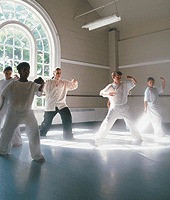Tai Chi

Although Tai Chi was originally developed as a method of self-defence, research has confirmed what the Chinese have known for centuries: regular practice has many health benefits including increased physical functioning and mental well-being. This is why Tai Chi is often referred to as "meditation in motion.

Although Tai Chi was originally developed as a method of self-defence, research has confirmed what the Chinese have known for centuries: regular practice has many health benefits including increased physical functioning and mental well-being. This is why Tai Chi is often referred to as "meditation in motion."
Tai Chi, which means "supreme ultimate fist," is an ancient Chinese martial art that incorporates mind, body, and spirit. The slow, continuous movements are designed to impart powerful physical skills and to improve the flow of energy, or chi, throughout the body. The ultimate goal is to improve the mind-body connection.
Find Your Form
A standard Tai Chi routine often takes only 10 minutes to perform, although a more advanced form may take as long as an hour. Tai Chi sessions typically begin with meditation to calm and focus the mind, followed by a gentle warm up. Tai Chi participants are taught to focus on their centre of gravity, the area just below the navel called the dantian.
After the warm up, instructors teach a series of slow, flowing movements that, when performed together, constitute a "form." The greatest focus is placed on coordinating deep breathing with each movement.
Although great strength can be gained from performing Tai Chi regularly, brute muscular power is not emphasized. Instead, the intrinsic strength of the bones, tendons, ligaments, and musculature is developed through relaxation and proper structure. The goal is to remove all tension from the muscles and joints, using just enough muscular effort to execute the forms while staying present and calm. Posture improves while moving the body through forms with great emphasis on correct body position.
Count the Benefits
According to a review done in the Harvard Health Letter, Tai Chi reduces stress hormones and improves balance. The Mayo Health Letter states that practicing Tai Chi reduces the risk of falling by 40 percent. This is significant because falling is the leading cause of death in the elderly.
When performing Tai Chi, movements are smooth and continuous. Range of motion is improved and, therefore, flexibility increases. It is for this reason that the American Journal of Physical Medical Rehabilitation states that Tai Chi is a safe alternative exercise for people suffering from rheumatoid arthritis.
Another important Tai Chi principle is correct breathing. Breathing should be slow, gentle, and through the nose. Deep diaphragmatic breathing is practised, as opposed to shallow breathing into the upper lungs. According to the John Hopkins newsletter Health After 50, this technique decreases blood pressure, breathing rate, heart rate, and muscle tension. The same publication found that this deep-breathing technique may improve fitness levels in people with chronic heart failure.
Slow Down
Tai Chi is a very attractive form of exercise to many because, if done properly, it does not leave you stiff or sore. Participants state that it teaches them to slow down, yet work more effectively. They become more productive by reducing speed while increasing focus. Tai Chi teaches them movement with ultimate relaxation, even in moments of effort. That's something people at all levels of fitness can benefit from.




